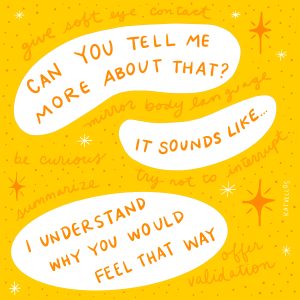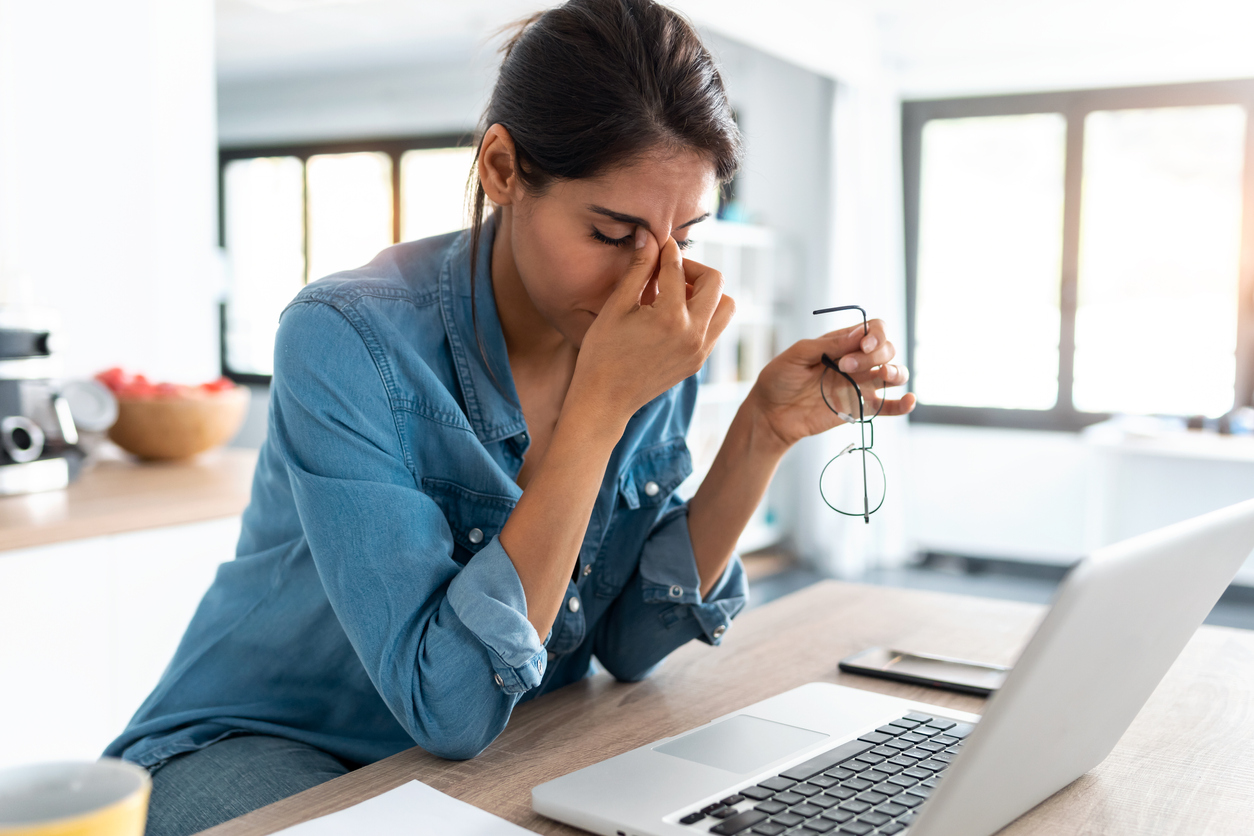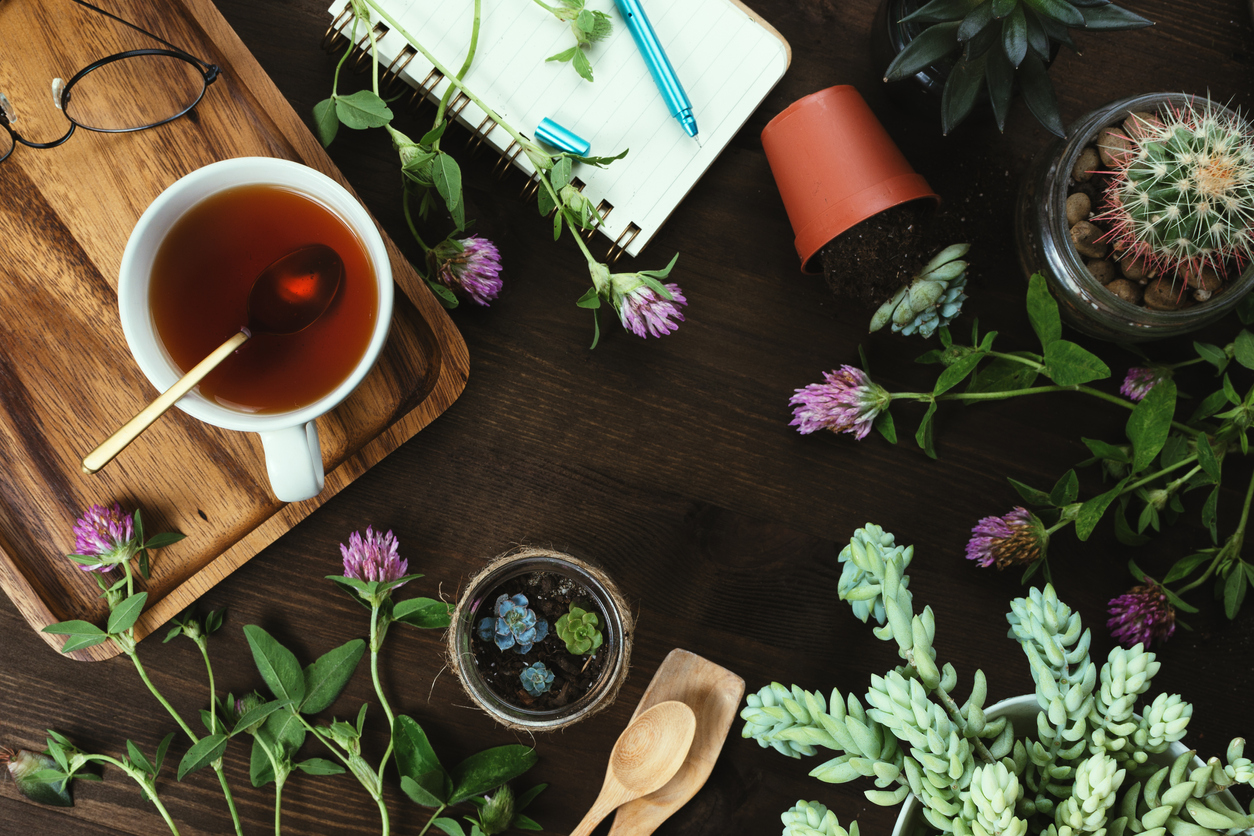We all love being listened to — in fact, listening is one of the key elements of intimacy in a relationship. Of course, actually doing that great listening … that’s often another story. It’s way easier to talk about ourselves than to listen.
Research shows 30-40% of our everyday speech is devoted to people talking about their subjective experience, and “upwards of 80% of posts to social media sites (such as Twitter) consist simply of announcements about one’s own immediate experiences.”
This is, as you might guess, not super amazing for connecting with others around you — but the good news is, the “lost art of listening” isn’t all that hard to regain.
Here are 5 strategies for being a better listener (that will make any kind of interaction better):
1. Cultivate a listening “mindset” — not listening skills.
A lot of times people try to work on their listening by practicing skills. And of course there’s nothing wrong with skills, but without the right mindset, the skills are going to fall flat. Like so many other things about human relationships, listening is about the intention and mindset you bring to the interaction, not just the “best practices” involved. So start out by reframing your mindset, and setting an intention to give, not take, as you listen.
Kate Murphy, author of You’re Not Listening and GLP podcast guest, lists out some of the most common bad-listening behaviors — playing on your phone, interrupting, etc. — then says,
“If you do these things, stop. But that alone is not going to make you a good listener. It will just make it less obvious that you’re a bad listener. Listening is more of a mindset than a list of dos and don’ts. It’s a very particular skill that develops over time by interacting with all kinds of people … For sure, listeners take on more risk by making themselves available when they don’t know what they’ll hear, but the greater risk is remaining aloof and oblivious to people and the worlds around you.”
Starting with this kind of approach can also help you avoid two common “bad listening” behaviors: (1) pretending like you’re listening, but actually just waiting for the other person to stop talking so you can interject with your own agenda, and (2) interrupting. Shifting from an intention of transacting in conversation to one of connecting in conversation makes all the difference.
2. Come to the conversation curious
One of the fastest ways to shut down a conversation is to assume you know how it’s going to go. And yet, so many people show up to an interaction already kind of having had it in their heads. While showing up to a conversation with assumptions and preconceived notions is human…
“Presuppositions … play important explanatory roles in pragmatics and semantics. Not all presuppositions in a conversation are equally available, or accessible, to speakers at a given stage in a conversation.” (The Fragmented Mind)
… it’s also terrible for listening, because it puts you in the position of just waiting for your turn to speak. Researchers Dr. Michael Nichols and Dr. Martha Straus differentiate between these two types of behaviors as active attention — aka, “I’m right there with you, I’m engaged in what you’re saying!” — vs passive attention, where you’re attending to the conversation, but really mostly interested in what’s going on in your own head.
“Give your undivided attention. Spend more time looking into someone’s eyes than you do looking over their shoulders. Undivided attention is such a rarity these days, people crave it desperately. When it is offered, it is often experienced on the level of a gift. Give that gift. To be interesting, be interested. Counterintuitive as it may sound, you don’t need to say much to be interesting. You just need to ask the right questions. Most people will find you interesting if you are deeply interested in them. Stop thinking about what to talk about; start thinking about what to ask.” (How to Live a Good Life).
3. Let people know you’re listening
Study after study has shown how we basically have no really good grasp on what anybody else is doing at any given time. This goes for listening too — you might be listening really attentively, but if that process happens purely in your head, your conversational partner might not know.
Fortunately, this is super easy to fix by using check-ins and validation. When someone says something, instead of you jumping right in to rattle off your own thoughts and advice, instead, check in with a short summary. Saying something like, “So, what I’m hearing is…” or, “It sounds to me as if…” can help you ensure that you’ve heard the other person correctly, show them that you’re paying attention, and help you both dive into a deeper conversation or find more understanding.
“Ask, listen, pause, and ask. Once you’ve asked questions that elicit someone’s response, stop talking. Let them talk, and just listen. Really listen. You’ll be better able to respond to moments, ideas, tangents that almost always hold the best parts of the conversation. Don’t think ahead to what you’re going to ask next. Just listen. When your partner is done, pause for a moment, then respond to what was offered and ask another question.” (How to Live a Good Life).
Similarly, if someone opens up to you or shares something tender, make sure you show them that you hear them and you care. You can respond with something like, “I understand why you would feel that way,” or “It sounds like you have reason to feel that way.” It doesn’t have to be forced or scripted. Just offer anything that’ll let the speaker know that you’ve heard what they have to say, and you’re not there to judge them. (This is one of several types of empathy often employed in therapy.)
 Art by Kat Vellos
Art by Kat Vellos
4. Cultivate conversational sensitivity.
We all know that there’s more to a conversation than just the words at play — silences, pauses, context, and non-verbal communication are all a part of it, too. But a lot of times we choose to kinda gloss over all of that in our listening because it’s complex, and takes more work than just taking people’s words at face value.
Conversational sensitivity is the skill of deliberately developing your focus on all those non-obvious elements of conversation.
From You’re Not Listening:
“People who have conversational sensitivity not only pay attention to spoken words, they also have a knack for picking up on hidden meanings and nuances in tone. They are good at recognizing power differentials and are quick to distinguish affectation from genuine affection. They remember more of what people say and tend to enjoy, or at least be interested in the conversation. Conversational sensitivity is also thought to be the precursor to empathy, which requires you to summon emotions felt and learned in previous interactions and apply them to subsequent situations.”
This is definitely a lot more involved than your average listening — but the rewards are well worth it, because you have the chance to get so much more from the interaction, and know the other person on a much deeper level.
“Listening a little harder — extending what we do automatically, extending ourselves a little more — is one of the best ways we can be good to each other.” (The Lost Art of Listening).
Plus, it even feels good on a biological level for the person being listened to:
“Neural activation in the ventral striatum was enhanced by perceiving active listening, suggesting that this was processed as rewarding. It also activated the right anterior insula, representing positive emotional reappraisal processes.” (Social Neuroscience).
In other words … when someone listens to you, you feel good about yourself, and you experience physical processes in your brain that feel really good.
And while it does take time to develop conversational sensitivity, it really does come down to practice, and putting yourself into conversation with people who are different from you. Come into conversations looking for those layers, stop the conversation when you need to clarify something or check your assumptions, and over time, you’ll develop the skill.
“Notice what’s not being said. The vast majority of communication is nonverbal. Studies have found that words account for only 10 to 30 percent of communication. What makes up the other 70 to 90 percent? Nonverbal cues, like body language, facial expressions, vocal cadence and intonation, breathing, physical positioning. Learn to see and hear not just what’s being spoken, but what’s being said beyond words. If someone is constantly looking around while you’re speaking, you’re not holding their attention. Look at their body. If their feet are turned away from you, they’re just waiting for a chance to exit. Are they leaning in (engaged), leaning back (aloof), arms open and animated (excited), arms crossed (closed and defensive)? You can study up on so much of this, but truth is, if you just pay attention, people’s subtler cues are pretty easy to translate, and they often speak far more loudly than anything they’re actually saying.” (How to Live a Good Life).
5. Listen in ways that work for you and your brain
Most listening strategies are designed for people with so-called neurotypical brains. And while they may work for people with neurodiverse brains as well, it turns out that people whose brains are wired a little differently may actually need to listen differently.
For instance, people with ADHD may process audio information differently than others, meaning that traditional “listening strategies” might not work the same way for them. In ADHD: A Hunter in a Farmer’s World, author Thom Hartmann talks about how when you talk to a neurotypical person they have a “congruence of verbal and visual images” — AKA if I say “Go to the store and get paper towels, then grab a smoothie on the way home,” then their brain hears the words and also makes a picture of the process.
Those with ADHD may not do that, only hearing the words and not automatically making the pictures, which makes for a less “sticky” memory, and makes it harder to pay attention. But if you remind the person with ADHD (or if they train themselves) to visualize what’s being said, then they create a much richer memory and deeper understanding.
Similarly, people with ADHD as well as those on the autism spectrum may find that fidgeting — typically a “good listening” no-go — is actually really helpful, because it helps keep their brain engaged enough to focus on what’s being said.
“Adding stimulating activities such as color, novelty or physical activities into routine tasks, one can provide the optimal level of stimulation that they require, which therefore, allows them to have improved task performance [aka listening] and reduced disruptive behaviors…” (Semantic Scholar).
There’s so much more to be said about this, but long story short? Listen in ways that work for you, and that are in line with your wiring and natural strengths, rather than trying to fit into some sort of “good listening” box.
Let’s Recap:
— Listening is incredibly important, but we tend to get so caught up in our own heads, assumptions, and emotions that we often don’t really listen. The good news is, the “lost art of listening” isn’t all that hard to regain.
— Start by reframing good listening as a mindset, not a set of skills. It’s all about the intent and empathy.
— Come into conversations curious. Nothing stalls connection faster than having an interaction in your head beforehand.
— Let people know you’re listening. Humans are notoriously bad at guessing what others are doing. Using check-ins and validation can keep you on the same page.
— Cultivate conversational sensitivity. Listening to the non-obvious elements of a conversation is so important for deeper connection — and you develop this skill by putting yourself in conversation with people different from you.
— Listen in ways that work for your brain. Different brains process auditory information differently. Find out what works for you and go with it, even if it’s the “wrong way to listen”.
You’re probably not going to become a master-level listener overnight — but you really can become a much better listener by using even one of these strategies. So now the question is … which one are you going to try first? Remember, every single one of these strategies only gets better with practice, so choose one to focus on, and see what happens!
Love research-backed deep-dives into subjects like these? The GLP newsletter family is for you! We craft each email with an intention to connect, and love getting to know each and every one of you. Join us here.



